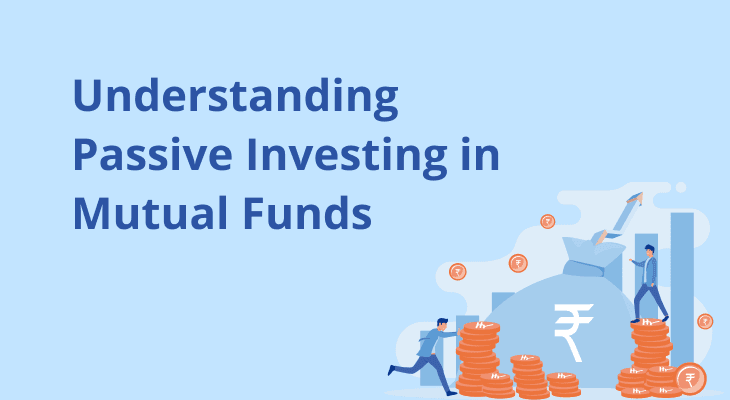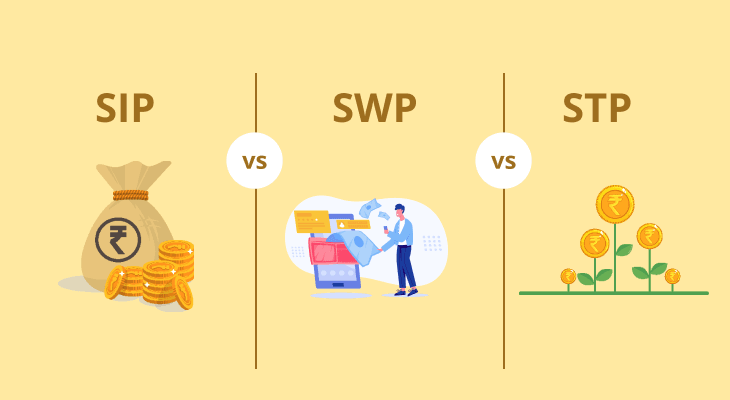
What Is Passive Investing In Mutual Funds?
Passive investing in mutual funds is an approach where your investment aims to replicate the performance of a market index instead of actively selecting individual stocks. Rather than trying to beat the market, passive funds seek to match it by investing in the same stocks and in the same proportions as the chosen index.
For example, a normal Nifty 50 Index Fund will hold the same 50 companies in the same weights as the Nifty 50 Index. If the index gains 10% in a year, the fund will aim to deliver nearly the same return, minus minimal expenses, and tracking error if any.
This strategy is gaining attention in India, especially in today’s volatile markets where even seasoned fund managers struggle to consistently outperform benchmarks. Passive mutual funds offer a simple, low-cost way for beginners and experienced investors alike to participate in market growth without complex decision-making.
How Passive Mutual Funds Work
Passive mutual funds aim to mirror the performance of a benchmark index. Instead of relying on a fund manager’s personal judgment to pick stocks, these funds follow a rules-based approach. Their primary goal is to match the returns of the index as closely as possible after deducting minimal expenses.
Full Index Replication vs. Sampling
- Full replication means the fund buys every single stock in the index in the exact same proportion. Suppose you invest in a Nifty 50 Index Fund. If Reliance Industries makes up 10.4% of the Nifty 50, the fund will also allocate 10.4% of its total assets to Reliance shares. As a result, if Nifty 50 rises by 8% over a year, and the fund’s expense ratio is 0.2%, you can expect predictable net returns of around 7.8%, assuming no tracking error.
- Sampling is used for large indices where full replication may be costly. Here, the fund invests in a representative sample of stocks that closely mimic the index’s performance. For example, if an index has 500 stocks (like the Nifty 500), the fund might only hold 100 carefully chosen ones, still matching the index’s sector weightage and risk-return profile.
Transparent, Rules-Based Structure
The portfolio construction is entirely rules-driven. If a company is in the index, it will be in the fund. If the index removes it, the fund will too. This transparency is one reason investors trust passive funds for predictable exposure.
Rebalancing and Tracking Error
Since index constituents change periodically, passive funds must rebalance holdings to stay aligned. Index rebalancing happens periodically, quarterly, semi-annually, or annually depending on the index provider. If the Nifty 50 increases the weight of a company from 5% to 7% in its latest review, the passive fund will buy more stocks of the company to match the new allocation.
Slight differences between the fund’s returns and the index’s returns are known as tracking error. Lower tracking error means the fund is closely following the index. For example, if the Nifty 50 delivers 10% in a year and your fund delivers 9.85%, the tracking error is 0.15%. A tracking error under 0.5% is generally considered efficient for a large-cap index fund.
Types Of Passive Funds
There are various types of passive funds categorised based on their structure and performance. Prominent categories include:
Index Funds
These mutual funds replicate indices like Nifty 50, Sensex, Nifty Next 50, etc. They can be bought directly from the AMC or an online mutual fund platform, and do not require a Demat account.
Exchange-Traded Funds (ETFs)
ETFs also track indices but trade like shares on the stock exchange. You need a Demat account and can buy or sell them at intraday prices.
Smart Beta / Factor Funds
These funds tweak traditional index rules to tilt towards certain factors such as low volatility, high dividend yield, or momentum, aiming for slightly better risk-adjusted returns.
Fund of Funds (FoFs)
An FoF invests in other index funds or ETFs. This allows you to invest in multiple markets or asset classes through one product.
Gold ETFs / Commodity Tracking
Track the price of gold or other commodities, offering an easy way to invest without physically holding the asset.
Debt or Government-Security Passive Funds
Track debt market indices, such as G-Sec indices, for those seeking lower-risk, fixed-income exposure.
Key Advantages Of Passive Investing
Passive investment funds have grown in popularity for several strong reasons, such as:
Low Cost / Expense Ratio
Passive funds do not need expensive research teams or analysts, which allows them to keep expense ratios extremely low, usually below 0.5% for index funds and even lower for ETFs. Over the long term, even a 1% lower expense ratio can mean significantly higher final wealth due to compounding.
Diversification
By investing in all companies in an index, you automatically spread your risk across sectors and market leaders. For example, the Nifty 50 fund gives you exposure to banks, IT companies, energy giants, FMCG firms, and more in a single investment.
Reduced Manager Bias
No matter how experienced, active fund managers can make poor calls. Passive funds avoid this by following strict index rules. This means your returns are based on market movements, not individual judgment.
Predictable Performance
You can reasonably predict how a passive fund will perform compared to its benchmark. If the Sensex goes up 15% in a year, your Sensex index fund will deliver close to that, minus minor costs.
Ease for Beginners
Since you don’t need to track markets daily, passive funds are a good entry point for first-time investors seeking steady, long-term growth.
Potential Drawbacks & Risks Of Passive Investing
Although passive investing has a lot of benefits for beginners and seasoned investors alike, it is important to know their potential drawbacks and risks before investing.
- Tracking Error: A poorly managed passive fund may deviate significantly from the index, reducing efficiency.
- No Outperformance: Since the goal is to match the market, you will never “beat” it, even if opportunities exist.
- Sector Concentration: Some indices have a large weight in certain sectors (e.g., banks in Nifty 50), leading to overexposure.
- Market Inefficiencies: Passive funds may not benefit from market mispricing in smaller or mid-sized stocks.
- Liquidity Issues in Niche ETFs: Certain sector or thematic ETFs may have low trading volumes, causing price deviations from NAV.
Passive vs. Active: Which One’s for You?
Active funds aim to beat the market through research and stock-picking. Passive funds aim to mirror the market at a lower cost. Here’s a summary of the key differences between to help you decide which one suits you better:
Criteria | Passive Mutual Funds | Active Mutual Funds |
|---|---|---|
Objective | Aim to replicate the performance of a benchmark index like Nifty 50 or Sensex. | Aim to outperform a benchmark index through active stock selection and market timing. |
Management Style | Follow a rules-based, automated investment approach with minimal intervention. | Managed by fund managers who research, analyse, and make buy/sell decisions. |
Decision-Making | No subjective decisions, portfolio changes only when the index changes. | Fund manager decides stock weightages and portfolio allocation based on market outlook. |
Expense Ratio | Very low, usually 0.1%–0.5%, as no active research teams are needed. | Higher, often 1%–2.5%, due to research, analysis, and fund management costs. |
Performance Predictability | Highly predictable, closely matches the benchmark index returns minus costs. | Less predictable, can outperform or underperform the benchmark depending on decisions. |
Risk Level | Matches the market risk of the index. No risk from poor stock-picking decisions, but still exposed to market volatility. | Higher risk due to potential wrong calls by the fund manager, but also potential for higher returns. |
Tracking Error | Small difference between fund returns and index returns due to replication costs. | No concept of tracking error; performance depends on fund manager skill. |
Ideal For | Beginners and cost-conscious investors seeking stable market-matching returns. | Investors willing to take higher risk for the possibility of beating the market. |
Transparency | Portfolio is fully transparent since it mirrors the index. | Portfolio changes depend on the manager’s strategy and may not be disclosed immediately. |
Example | Nifty 50 Index Fund, Sensex ETF, Nifty Next 50 Index Fund. | Large Cap Fund, Mid Cap Fund, Multi Cap Fund managed by a specific AMC. |
- Passive is best if you want low costs, broad exposure, and are happy matching market returns.
- Active is best if you are willing to take higher costs for a chance of outperformance.
Many investors combine both strategies by using passive funds for the core of their portfolio and active funds for specific opportunities.
Passive Investing Trends In India
The passive investing space in India has grown at a record pace in the past decade. According to a report, in 2015, passive funds accounted for just 1.4% of mutual fund industry AUM. By 2025, this surged to over 17%.
Factors driving this growth include:
- Poor performance of some active funds in beating benchmarks.
- Lower expense ratios making passive products more attractive.
- Increased awareness via digital investment platforms.
- Regulatory encouragement for cost transparency.
As a result, several large institutions like EPFO have moved significant portions of their equity exposure to index funds and ETFs. Retail investors are now following suit, often combining passive mutual funds with systematic investment plans (SIPs).
Big AMCs such as Mirae Asset, SBI Mutual Fund, Nippon India Mutual Fund, UTI AMC, and Motilal Oswal AMC are leading the passive revolution in India, offering products tracking equity, debt, and commodity indices. With market maturity, factor-based funds and global index funds are also gaining traction.
Analysts expect passive fund AUM in India to continue growing within the next few years, aligning with global trends where passive products dominate new fund inflows.
Conclusion
Passive investing in mutual funds is a simple, cost-effective way to grow wealth by tracking market indices. While it removes the possibility of beating the market, it also shields you from poor stock-picking. For most beginners, a combination of passive funds for stability and active funds for potential alpha can be a balanced approach.
Additional Read: What is the Difference Between Active & Passive Funds?
FAQ
Are passive funds suitable for beginners?
Yes. Passive mutual funds are beginner-friendly because they remove the stress of stock selection and market timing. You get instant diversification, low costs, and performance that mirrors the market. For someone starting out, they are an easy, disciplined way to participate in equity markets while avoiding over-complication.
Can passive mutual funds outperform?
Technically, passive funds are not designed to outperform. Their goal is to match the index. However, in many cases, they have delivered better post-cost returns than active funds, especially when active managers struggle to beat benchmarks. This is because the low expense ratio leaves more of the gross return in your pocket.
What are smart-beta funds?
Smart-beta funds are hybrids between passive and active investing. They track indices constructed using specific factors like low volatility, value, or momentum. Instead of blindly following market-cap weightage, they aim to capture certain return patterns. For example, a low-volatility index fund focuses on stocks with historically lower price fluctuations.
How does tracking error affect returns?
Tracking error measures how closely a passive fund follows its index. A small tracking error means your returns are nearly identical to the index, which is ideal. A high tracking error could mean inefficient replication, poor execution, or liquidity issues, reducing the reliability of the fund for matching the index’s performance.
Do I need a Demat account to invest in passive funds?
If you choose an index mutual fund, you can invest without a Demat account, just like any other mutual fund. However, for ETFs, you must have a Demat account and a trading account since they are bought and sold like shares on the stock exchange during market hours.
Are passive funds safe?
They are as safe as the market itself. Since they track an index, their performance rises and falls with market trends. You are protected from poor fund manager decisions, but you remain exposed to market volatility. They are best for investors with a long-term horizon to ride out short-term fluctuations.
Which indices do Indian passive funds track?
Popular indices include Nifty 50, Sensex, Nifty Next 50, and sector-specific indices like Nifty Bank or Nifty IT. There are also thematic and international index funds, such as those tracking the S&P 500 or Nasdaq 100, allowing Indian investors to diversify globally.
Can passive funds be used for SIPs?
Yes, and it’s a recommended approach for long-term wealth creation. Regular SIPs in index funds help you average out purchase costs over time and benefit from compounding. This strategy also removes the emotional pressure of timing the market, which is a common beginner mistake.
Why are passive funds gaining popularity in India?
Multiple factors are at play: rising financial literacy, the inability of many active funds to consistently outperform benchmarks, global trends, and low costs. The convenience of investing online and the availability of index-based SIP options have also made passive funds more accessible to everyday investors.
How do I choose a passive mutual fund?
Look at the fund’s expense ratio, tracking error, and the credibility of the AMC. Ensure the benchmark index suits your investment goals. For example, Nifty 50 funds are best for large-cap stability, while Nifty Next 50 funds offer more growth potential but higher volatility.


